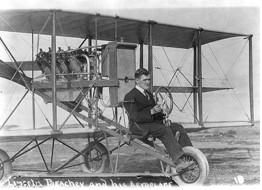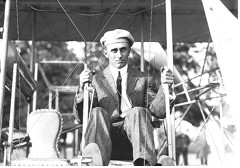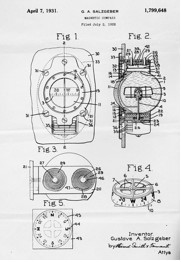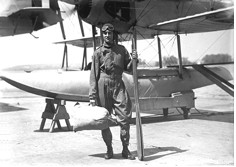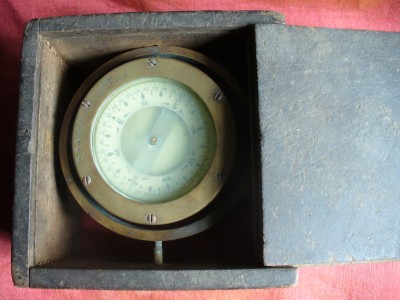
|
|
Star Compass Company by Gustave A. Salzgeber Although we are indebted to the Chinese for the origination of the compass and to various other inventions for its improvement, it was not until the early eighteen hundreds that the liquid or spirit magnetic compass was invented, at Boston, Mass. It is only natural then that Boston should be known as the home of the magnetic compass. Compasses made at Boston, Mass. are known and used the world over and for this reason it is regarded as the compass center of the world. The Star Compass Co. of Boston, Mass. had its origination in 1905 when it started the manufacture of mariners (spirit) compasses in a small way without the aid of power other than that which one could produce through his own efforts upon a foot treadle. However it was not long before the quality and practicability of the compass was recognized and accepted, which enabled the company to acquire better equipment, larger quarters and increase its line of compasses from one to eighteen sizes suitable for use on the smaller boat or the largest ocean going steamers. It was while busily engaged in the manufacture of mariners compasses that the writer's attention was called to the possible use aviation might have for the magnetic compass. This was in 1907 and the thought was inspired by the activities of that great aviator Lincoln Beachy who with a cigar shaped dirigible of his own invention was making exhibition flights at Revere Beach, Mass.
These flights of Beachy's if they did nothing else for aviation gave to the industry its first navigating instrument, for the writer set himself to the task of constructing an aviation compass. In due time the compass was complete and perfected as near as possible, but who was to try it out and test it while in flight. Here was a problem as great if not greater than the developing of the compass itself and being interested in aviation from the ground only it became quite obvious that my compass would have to wait for further development of the airplane. It was with much regret that the compass was laid aside but not forgotten. Three years passed quickly but the development of aviation in this country was very slow as compared with that of European countries. Interest was renewed however with the first Harvard-Boston Aviation meet at Waltham, Mass. in 1910. This meet brought to the notice of the public a Boston young man who proved to be the sensation the most when he made a sensational flight to the White Mountains. This latest of aviators was no other than the dare-devil aviator Harry N. Atwood who astonished the world with what was considered a long distance flight.
Here at last was a chance for our aviation compass. We lost no time in trying to place it with this latest of hero's, Aviator Atwood. To locate him was no easy task. However my opportunity arrived about five o'clock one morning, when I was awakened by the noise of what I was sure was an airplane. Hurriedly dressing I rushed out of doors as did several of my neighbors and sure enough there was an airplane slowly descending to a landing, as I thought on Franklin Field. Quickly grasping my compass I started on the run for the field but to my astonishment I found on my arrival that the plane was continuing on to the Franklin Park Golf Links, another mile and one half beyond. I lost no time in getting to the golf links and was well rewarded for my efforts, for there the plane (which had run out of gas) had been safely landed by none other than the sensational aviator H. N. Atwood. Although a large number of persons were on hand asking questions and keeping the aviator busy I lost no time in offering him my compass which he at once gratefully accepted but which he found would not fit to the strut of his machine. It was agreed that after minor changes had been made the compass should be delivered to his hotel. Thus after three long years I had at last placed my compass with the greatest flyer of the day. Atwood's activities were of short duration and he gradually stopped flying after the second Harvard-Boston Aviation Meet in 1911. This second Boston meet brought forth a number of well known aviators among them Lieut. Milling, Earl Ovington, Harry Atwood, Lincoln Beachy, Eugene Ely and Grahame-White. At this meet Lieut. Milling and Earle Ovington distinguished themselves by winning prize money in the inter city flight. At this meet the first night landing was made by Lieut. Milling, U.S.A. This was accomplished by the aid of a bon-fire. It was at this meet that the writer presented to Lieut. Milling one of these early model airplane compasses and through his recommendation that the United States Army Signal Corps adopted our compass for exclusive use. During the 1912 Mexican outbreak at Vera Cruse the U.S.A. Signal Corps performed invaluable service and it was during this campaign that the writer was convinced that the compass had found its place in the aviation world and was worthy of further development. By this time we had given to the industry the first vertical dial compass, the luminous treated dial and indirect electric lighting.
By continuous research we have been able to keep pace with the changing designs and requirements of an ever changing industry. The most recent of our original improvements is the built-in compensating unit. This is an integral part of the compass and provides a simple adjustment for deviation, correction and entirely eliminates loose magnets. The spherical magnifying glass, another original feature, gives remarkable visibility and permits the use of a small dial, thus making available much needed panel space for installation of other instruments. Another welcome improvement was the Flush Mounting compass. Here was a great step forward for the benefit of the pilot who very often was badly cut or bruised about the head in making landings, by being thrown forward against the protruding compass. It has not just been the aviators of the older school that Star compasses have been associated with, for it was this company's privilege to supply the magnetic compass equipment for the historical flight of Lieuts. Maitland and Hegenberger whose entire flight of 2400 miles was laid and steered on a magnetic course.
Again on the Byrd Antarctic Expedition it was the product of this company that was personally chosen by Commander Byrd for this greatest of all exploring expeditions. Capt. Wilkins that great English explorer not only carried Star compasses into the north and over the pole but he too personally chose Star compasses for his equally daring exploits into the Antarctic regions.
NOTE: The above undated article was written by Gustave A. Salzgeber (1888-1979), founder of the Star Compass Co. Although Salzgeber began his company in Dorchester in 1905; he moved the company to Antwerp Street, East Milton by 1929. From 1929-1969 over 200,000 compasses were manufactured in his East Milton shop including the compass shown above which is in the collection of The Milton Historical Society. |

